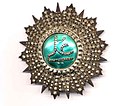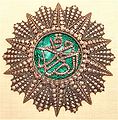| This article needs additional citations for verification. Please help improve this article by adding citations to reliable sources. Unsourced material may be challenged and removed. Find sources: "Order of Glory" Tunisia – news · newspapers · books · scholar · JSTOR (December 2018) (Learn how and when to remove this message) |

The Order of Glory (Turkish: İftihar Nişanı or Arabic: Atiq Nishan-i-Iftikhar) was a Tunisian honorary order founded in 1835 by Al-Mustafa ibn Mahmud the Bey of Tunisia. The order was awarded until the constitutional role of the Bey was abolished following 1957.
Background information
The order essentially existed in two different models: the first awarded from its creation in 1835 and the second following 1859. Initially awarded in a single class, the order was reorganized and awarded in five classes following 1843 and expanded to six classes in 1882:
This order could be awarded to people of French nationality, cities (like Verdun), and other notable foreigners with some connection to Tunisia. It was given by the bey of Tunis on a proposal from the chief vizier for Tunisian subjects and, in all the other cases, on a proposal from the resident general of France (which occupies de facto the post of Foreign Minister of Tunisia). Although the resident general has a quota, this last remains about it always the large Master. Each bey having put his monogram on the center of the decoration, it is possible to determine the approximate award date of each order.
Examples of the decoration
The typical decoration is manufactured from solid silver with green and red enameled rays for some classes. The reverse of the decoration as well as the bow and suspension ring may have jeweler, date, and acceptance markings. These particular decorations (second model) were awarded by Ali Muddat ibn al-Husayn Bey (1882–1902).
-
 JM Abdul Aziz seen wears the Commander around his neck.
JM Abdul Aziz seen wears the Commander around his neck.
-
 Grand-officer (Tunisian made)
Grand-officer (Tunisian made)
-
 Commander (detail) (Tunisian made)
Commander (detail) (Tunisian made)
-
 Officer (detail) (French made)
Officer (detail) (French made)
These particular decorations were awarded by Muhammad III as-Sadiq Bey (1859–1882) and illustrate the differences that can exist between French and local Tunisian manufactured decorations:
Text of the diploma
Awardees were given a diploma which in general had the following text (translated):
Praises with God alone! On behalf of the Servant of God glorifié, of that which puts as a God his confidence and the care of its destinies leaves him, , Possesseur of the Kingdom of Tunis with on the proposal of Our Foreign Minister, which made known to us your noble qualities, We conferred this decoration to you. Our name is engraved there and it is class of Our Kind of Nichan Iftikhar. Carry it with joy and happiness! Writing it .
These two diplomas awarded to the same person in 1927, commander class, illustrate the order's typical diplomas:



